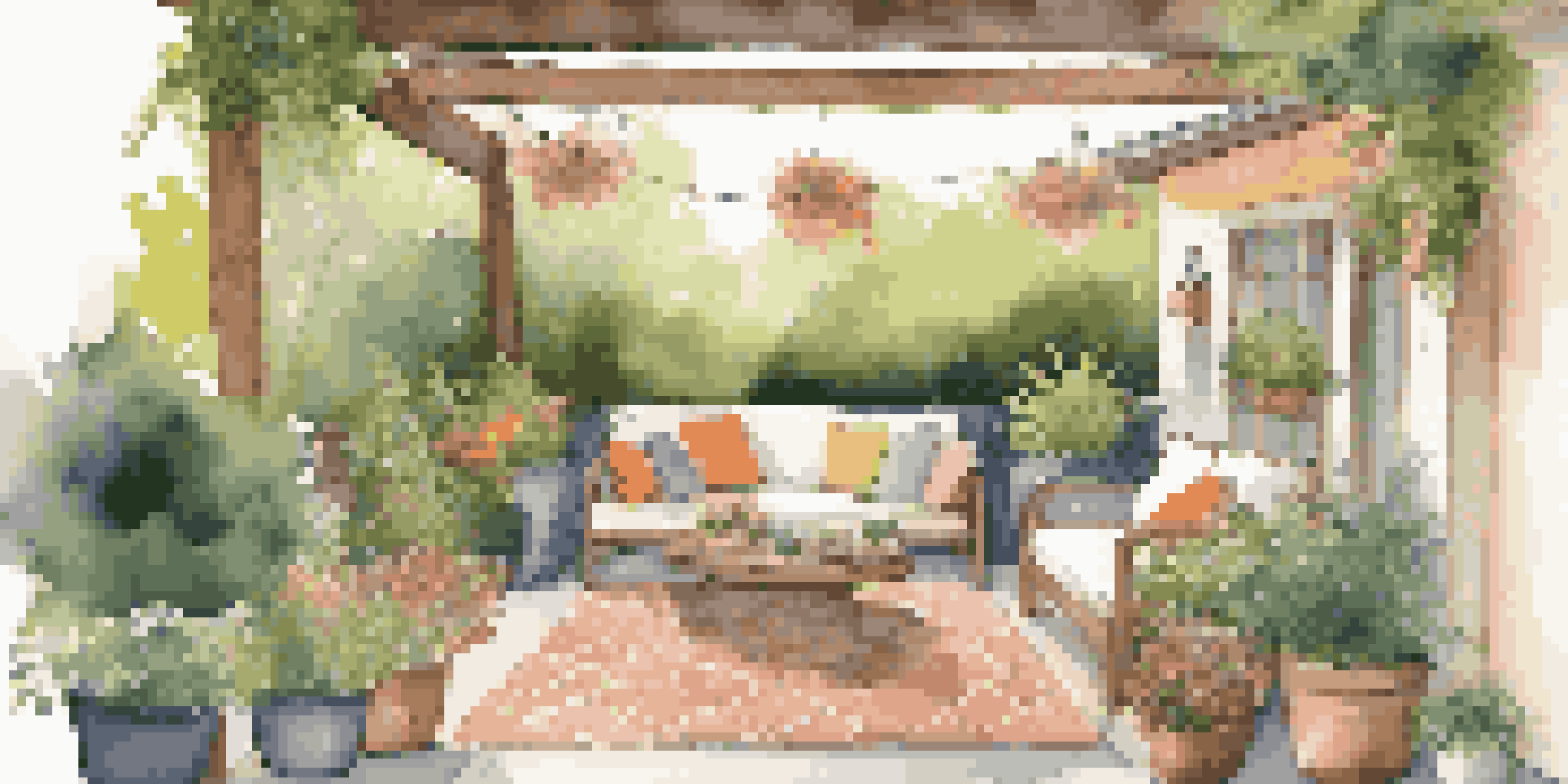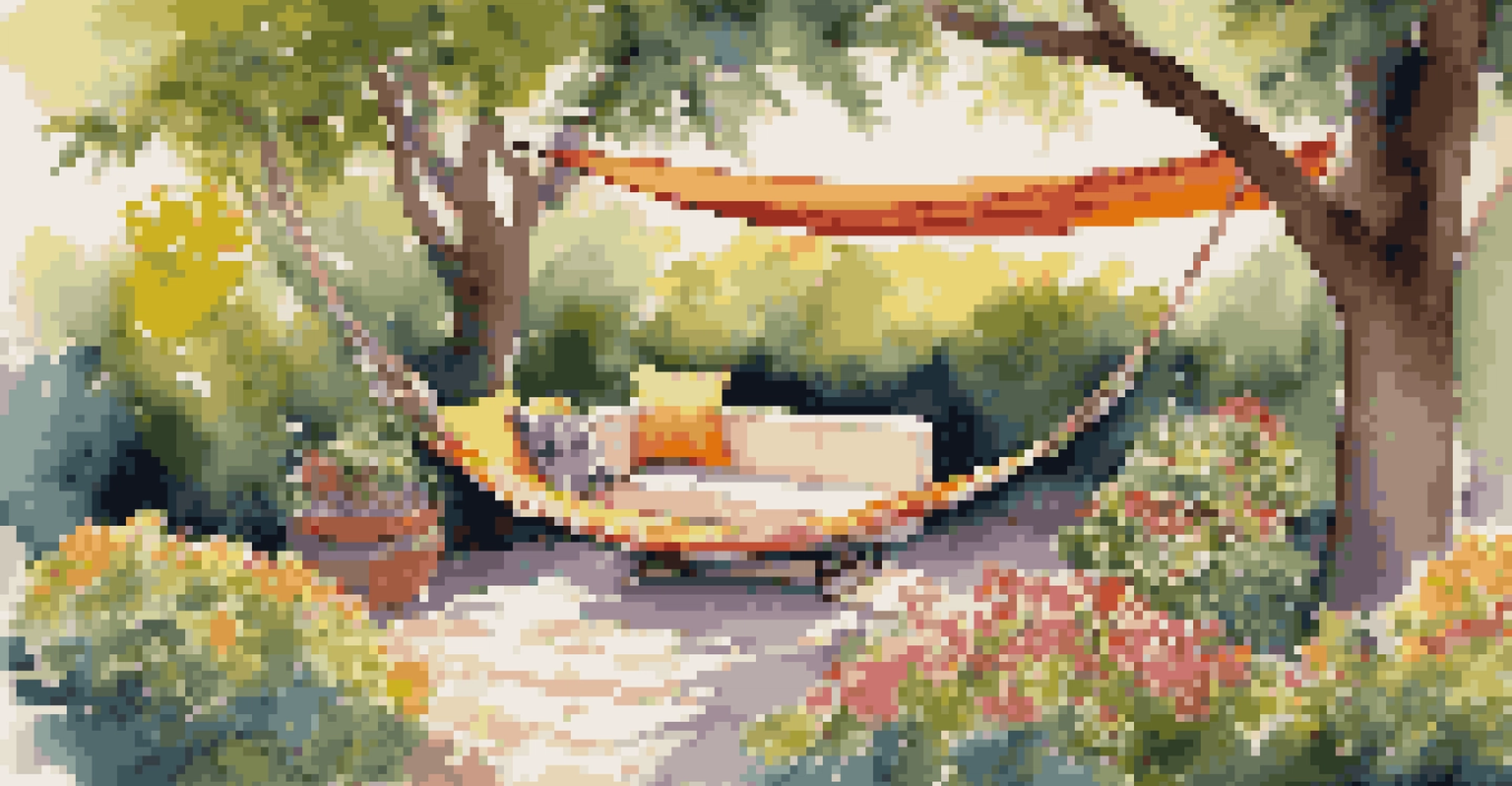Creating a Multi-Functional Outdoor Living Space

Understanding the Concept of Outdoor Living Spaces
Outdoor living spaces extend your home’s footprint, allowing you to enjoy nature while having the comforts of indoor living. Think of them as your backyard oasis, where relaxation meets functionality. This concept has gained popularity as homeowners seek to connect with the outdoors and create environments that accommodate various activities.
The outdoors is a place for reflection, relaxation, and renewal; it invites us to slow down and reconnect with the natural world.
When designing an outdoor space, consider how you plan to use it. Is it for family gatherings, a quiet retreat, or perhaps a space for entertaining friends? By identifying the primary functions of your outdoor area, you can tailor your design to meet those needs, making it both enjoyable and practical.
A well-planned outdoor living area can significantly boost your home's value and appeal. It serves as an extension of your home, offering a unique space for different activities, from cooking and dining to relaxation and recreation. By investing in this transformation, you'll create a welcoming environment that can be enjoyed year-round.
Choosing the Right Location for Your Outdoor Space
The location of your outdoor living space can greatly influence its usability and enjoyment. Consider factors like sunlight, shade, and wind patterns to determine the best spot for your space. For example, if you love sunbathing, a sunny area might be ideal, while a shaded spot could be perfect for a cozy dining area.

Additionally, think about the view from your space. Positioning your outdoor area to take advantage of beautiful landscapes or gardens can enhance your experience. It’s like creating a natural frame for your outdoor activities, making every moment spent outside visually appealing.
Create Functional Outdoor Zones
Dividing your outdoor space into distinct zones for dining, lounging, and gardening enhances usability and enjoyment.
Lastly, accessibility is key. Ensure your outdoor living area is easily reachable from your home, allowing for smooth transitions between indoor and outdoor spaces. This accessibility makes it more likely that you’ll use the space, whether for a quick coffee break or a weekend barbecue.
Incorporating Essential Furniture and Amenities
When designing your outdoor living space, selecting the right furniture is crucial. Opt for durable materials that can withstand the elements while still providing comfort. For example, weather-resistant cushions and sturdy tables can make your space inviting without compromising on longevity.
Nature does not hurry, yet everything is accomplished.
Think about the activities you enjoy and choose furniture accordingly. If you love hosting dinner parties, a large dining table with comfortable chairs could be the centerpiece of your space. Alternatively, if relaxation is your goal, consider adding lounge chairs or a hammock for those lazy afternoons.
Incorporating amenities like an outdoor kitchen or fire pit can elevate your outdoor experience. These features not only enhance functionality but also encourage more time spent outside, creating memorable moments with family and friends around the warmth of a fire or enjoying a freshly grilled meal.
Creating Zones for Different Activities
Dividing your outdoor space into distinct zones can maximize its use and functionality. Consider areas for dining, lounging, and even gardening. Each zone can serve a specific purpose, making your outdoor living area versatile and enjoyable.
You can define these zones through various means, such as outdoor rugs, furniture arrangement, or even landscaping elements like hedges or flower beds. For instance, placing a rug under your dining table can visually separate the dining area from the lounge space, creating a more organized feel.
Enhance with Lighting and Decor
Incorporating thoughtful lighting and personal decor elements can transform your outdoor area into a cozy and inviting retreat.
This zoning approach not only enhances the aesthetic appeal but also improves the flow of movement. Guests can easily transition from one area to another, whether they're grabbing a drink or moving to a cozy spot for conversation, ensuring everyone feels comfortable and engaged.
Adding Greenery and Landscaping for Appeal
Integrating plants and landscaping into your outdoor living space can bring it to life. Greenery adds color, texture, and a sense of tranquility, making your space feel inviting. Consider using a mix of potted plants, flower beds, and even vertical gardens to create visual interest.
Choosing the right plants is essential, as some thrive in specific climates or lighting conditions. Research which plants suit your local environment and the amount of sunlight your space receives. For example, succulents are great for sunny spots, while ferns can thrive in shaded areas.
Incorporating landscaping elements like pathways, seating areas, or water features can enhance your outdoor ambiance further. A small fountain can create a soothing sound, while well-placed lighting will allow you to enjoy your outdoor space even after the sun sets.
Utilizing Lighting to Enhance Your Outdoor Experience
Outdoor lighting plays a significant role in setting the mood for your space. It allows you to extend the use of your outdoor area into the evening, making it perfect for gatherings or quiet nights under the stars. Consider a mix of ambient, task, and accent lighting to create a well-lit, inviting atmosphere.
String lights can add a whimsical touch to your dining area, while lanterns or candles can create a cozy atmosphere for lounging. For functional areas, such as cooking spaces, brighter task lighting will ensure safety and visibility when preparing meals.
Choose the Right Location
Selecting the ideal location for your outdoor living space, considering factors like sunlight and views, greatly influences its enjoyment.
Don’t forget about energy efficiency! Solar-powered lights are an excellent eco-friendly option that can illuminate your outdoor space without increasing your utility bills. By utilizing clever lighting solutions, you can create a warm and inviting environment that draws you outside, no matter the time of day.
Incorporating Personal Touches and Decor
Adding personal touches and decor can make your outdoor living space uniquely yours. Whether it’s through colorful cushions, decorative planters, or artwork, these elements infuse your personality into the design. Think about what reflects your style and enhances the overall ambiance of your space.
Consider seasonal decorations too; switching out cushions or table settings can keep your outdoor area fresh and inviting throughout the year. For instance, vibrant colors in summer can be replaced with warm tones in autumn, creating a space that evolves with the seasons.

Remember, these personal touches don’t have to be extravagant. Simple changes, like using family heirlooms or DIY projects, can add character while telling a story. This sense of personalization will make your outdoor living space feel like an extension of who you are, inviting others to share in your joy.